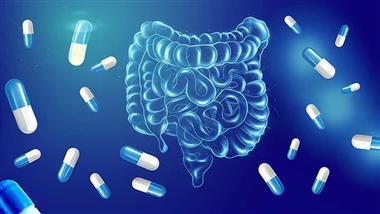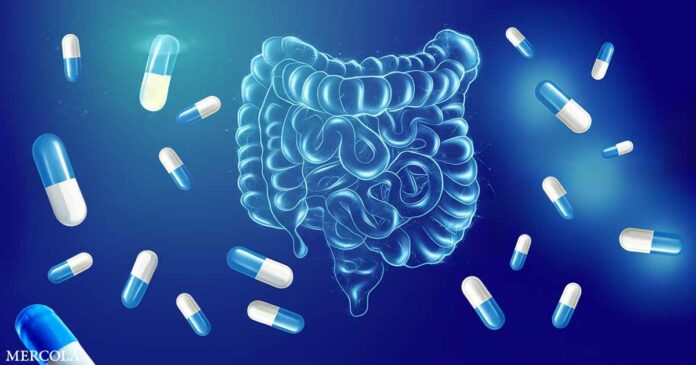
Story at-a-glance
- Bacteria develop antibiotic resistance through multiple mechanisms including intrinsic resistance, genetic mutations, and DNA transfer between bacteria, with resistant strains persisting in the gut for approximately one year
- Even brief antibiotic use permanently alters gut microbiome diversity, with resistant bacteria multiplying and beneficial strains being eliminated, creating long-term gut dysbiosis
- A country’s overall antibiotic consumption directly impacts an individual’s gut health. High antibiotic-use nations carry more antibiotic resistance genes even without taking antibiotics themselves
- Keystone strains are affected by antibiotics, and overall gut diversity is reduced as well
- Protecting gut health involves avoiding antibiotics, consuming probiotic-rich foods daily, reducing linoleic acid (LA) intake, supporting keystone bacteria, and considering natural antimicrobial alternatives
Antibiotic abuse is a pervasive public health concern around the world. According to the U.S. Centers for Disease Control and Prevention (CDC), 2.8 million cases of antibiotic-resistant infections are diagnosed yearly, and 35,000 people die from it.1 But how do bacteria evade antibiotics, exactly? As it turns out, bacteria are hardy microorganisms that adapt to antibiotics in different ways:2
• Intrinsic resistance — A change in structure or components through evolution eventually creates resistance.
• Acquired resistance — Bacteria begin to resist antibiotics through genetic mutations by “borrowing” DNA from bacteria already resistant.
• Genetic change — Bacteria are able to change protein production, which creates components that antibiotics cannot recognize and eventually eliminate.
• DNA transfer — Crosstalk occurs between different bacteria, allowing them to share resistant DNA through gene transference.
That said, taking antibiotics is one of the worst things you can do for your health. According to new research, even using it for a short while already creates lasting changes in your gut microbiome, making recovery hard.
Brief Antibiotic Use Triggers Lasting Resistance in Your Gut
In a study published in Nature, researchers set out to pinpoint if short-term antibiotic use changes gut bacteria, specifically by creating antibiotic-resistant strains, and whether these have lasting effects afterward.3
• Antibiotics create resistant strains right away — The study involved 60 healthy adult participants who were given 500 milligrams of ciprofloxacin, a widely prescribed antibiotic, twice a day for five days. After analyzing stool samples over a 20-week period, the researchers had an alarming revelation — within just a few days, previously susceptible bacteria evolved into resistant strains capable of surviving the antibiotic treatment.
About 10% of gut bacteria populations rapidly developed resistance through a mutation in a gene known as gyrA. This mutation specifically altered an enzyme (DNA gyrase), rendering ciprofloxacin ineffective against these bacteria.
• The impact of gyrA — According to the study, out of 2.3 million genetic variants identified by reconstructing 5,665 genomes, 513 of those underwent sweeping changes in the gyrA gene. Moreover, a Medical Xpress report covering the featured study noted:
“Once established, gyrA sweeps persisted beyond 10 weeks and were predicted to remain detectable for up to a year. Additional resistance-associated mutations occurred in other genes, though these events were less common and appeared in fewer species.”4
• Resistant bacteria have distinguished abnormalities — Usually, bacteria that develop resistance suffer some loss of fitness — the ability of bacteria to adapt and survive.5
However, the gyrA mutation observed in the featured study virtually had no negative impact on bacterial function. In other words, these resistant bacteria didn’t pay a biological “price” for resistance, making their long-term persistence extremely likely.
• Drug-resistant bacteria multiply with speed and ease — The team observed that during the experiment, multiple unrelated bacterial species independently developed the same gyrA mutation. This indicates that bacteria quickly adapt and protect themselves from antibiotics.
The long-lasting nature of this resistance was equally concerning. Even 10 weeks after antibiotic treatment ended, resistant bacteria remained dominant in the participants’ guts. Using predictive models, the researchers projected that these strains would persist for approximately a year without any further antibiotic exposure.
• Beneficial strains are forced out — The researchers noted an important factor influencing resistance development — the population of the bacteria in your gut. Strains that started off with larger populations experienced more dramatic reductions in numbers during antibiotic treatment, followed by a rapid rise in resistant strains afterward.
• Bacterial traits that create resistance remain in your gut — You’re not in the clear yet even after stopping antibiotics and the microbiome has stabilized. According to the researchers, the bacteria living in your gut have been permanently altered by antibiotics, causing new bacteria that enter your body to gain resistance as well:
“Commensal populations may therefore act as reservoirs for resistance traits that could transfer to pathogenic bacteria through horizontal gene transfer beyond the interaction with antibiotics.”6
The key takeaway here is that even short-term antibiotic use sets the stage for resistant bacteria to persist and cause long-term gut dysbiosis. Knowing this, it becomes clear that avoiding antibiotics unless necessary is essential to preserving your gut microbiome and lowering your risk for antibiotic-resistant bacterial infections.
Your Country’s Antibiotic Use Impacts Your Personal Gut Health
In a similar study published in Nature Communications, researchers revealed how antibiotic use, this time on a nationwide perspective, shapes the human gut microbiome. They analyzed samples from 3,096 participants currently not taking antibiotics across 10 countries, specifically looking at antibiotic resistance genes (ARGs), which are markers indicating bacteria is able to withstand antibiotics.7
The researchers grouped these gut microbiomes into two distinct patterns, also known as “resistotypes,” based on how many and what type of ARGs they contained. The first resistotype included gut microbiomes with fewer resistance genes, while the second was marked by significantly higher levels of these resistance genes.
• Higher rates of antibiotic sales had countries carrying more resistant gut microbiomes — The researchers reported that people from countries where antibiotic sales were high, like Spain, Italy, and Greece, showed notably higher levels of ARGs in their gut microbiomes compared to people in countries with lower antibiotic sales, like the Netherlands and Denmark.
• Resistance genes are persistent — Even if antibiotic use dropped suddenly, the ARGs could linger for years or even decades in a population. That’s because these genes embed themselves deeply in the resident commensal bacteria — the beneficial microbes normally found in your gut.
The result? Countries that historically had high antibiotic use retain elevated resistance levels long after usage patterns shift, exposing generations of people to a higher risk for antibiotic-resistant infections.
• International travel influences antibiotic resistance — When travelers from low-resistance countries visited high-resistance countries, their gut microbiomes quickly adapted, acquiring new ARGs from local bacteria populations. Once back home, these bacteria continued to thrive and spread, creating localized pockets of resistance even in regions previously unaffected.
• Antibiotic use creates conditions ideal for spreading resistance — While antibiotics are intended to kill off harmful bacteria, they also create an environment favoring resistant strains. With fewer competitors, resistant bacteria begin to take over, embedding themselves firmly into your gut microbiome. “Antibiotic usage will impose a selective pressure, not just on the target pathogens, but the whole microbiome,” the researchers said.8
• Non-users have more diverse gut microbiomes — Unsurprisingly, the researchers noted that antibiotics significantly impact gut microbiome diversity:
“Focussing [sic] on the gut microbiome, we observed two distinct phenomena. The first, observed in healthy individuals not currently taking antibiotics, was a substantial difference in both median total ARG abundance (five-fold) and richness (four-fold) across countries.”9
Ultimately, this study shows how national policies affect public health. By advocating for responsible antibiotic guidelines while avoiding unnecessary prescriptions on your part, the risk for developing resistant strains will be lower, both for you and the public.
Antibiotics Intake During Childhood Alter Your Gut Health
A study published in Microbiome investigated how early-life antibiotic use affects gut bacteria in the long run. Specifically, researchers from China aimed to understand exactly how antibiotics given during childhood could permanently disrupt gut microbial networks, influencing overall health and metabolism into adulthood.10
The study used an animal model, providing a clear framework for observing long-term effects. Test subjects were given ceftriaxone — a commonly prescribed antibiotic for children — for eight consecutive days when they were four weeks old. Then, researchers closely monitored their gut bacteria and metabolism for 14 months, which is a timespan that equates to early adulthood in humans.
• Even a short course of antibiotics early in life significantly reduced the bacteria diversity — Moreover, that diversity never fully recovered. In simpler terms, their gut microbiome lost many important bacterial species permanently, becoming less robust and less effective at supporting healthy digestion and immune function.
• Substantial alterations in the microbial community’s structure occurred — The microbial network, which is the complex interactions among different bacterial species, was heavily simplified after antibiotic exposure.
Typically, a healthy gut has many diverse bacteria interacting like a dense, stable web. After antibiotics, however, researchers found fewer connections between bacterial species, meaning the microbial community became fragmented and fragile. This made the microbiome more vulnerable to future disruptions.
• Early administration significantly affects gut health during adulthood — Although antibiotics were only given briefly in early life, the damage persisted for at least 14 months, which is essentially a lifetime for the test subjects. In other words, the research implies that taking childhood antibiotics will affect gut health as time goes on.
• Keystone strains are affected — The study highlighted how early antibiotic treatment specifically removes “keystone” bacteria. This refers to “taxa with a high impact on the structure and functioning ecosystems.” In this case, keystones mean bacteria that help maintain balance and stability within the microbial community. When antibiotics wiped out these crucial players, the whole bacterial ecosystem fell apart and never fully repaired itself:
“[T]he numbers of keystones of the antibiotic group in the 1st–7th months were obviously less than those of control, indicating that antibiotic use obviously reduced the number of key species in gut MENs. The numbers of keystones in the 8th, 9th, 10th, and 12th months were similar between the two groups. But obvious fluctuations appeared in the 11th, 13th, and 14th months,” the researchers said.11
How to Protect Your Gut from Antibiotic Resistance
If you’ve taken antibiotics before — or if you live in an area where antibiotics use is widespread — protecting your gut bacteria is your top priority. As I’ve written before, your gut health shapes everything from your immune function, to your energy, and even mental health. The key approach here is preventing antibiotic resistance from taking a hold of your life. To do that, here are my recommendations:
1. Avoid unnecessary antibiotics — Antibiotics should be your last resort, not your first choice. If you’re experiencing minor infections, your body usually handles these naturally. Don’t fall for the advice that you always need them for colds or mild infections, because as the studies have noted, even short-term antibiotic use dramatically increases resistance and disrupts your gut ecosystem.
2. Eat probiotic-rich foods regularly — Incorporate homemade fermented foods like sauerkraut, kimchi, yogurt, and kefir into your diet every day using traditional methods and clean, organic ingredients. The probiotics found in these foods help rebuild and maintain a diverse and healthy microbiome, which strengthens your overall health.
3. Minimize your intake of linoleic acid (LA) — Found primarily in vegetable oils, nuts, and ultraprocessed foods, LA damages your gut lining and promotes inflammation, weakening your gut health further. Swap out all products containing this toxic fat for healthier alternatives like tallow, grass fed butter, coconut oil, or ghee. This one shift alone will already dramatically improve your gut’s resilience.
4. Support keystone gut bacteria — Keystone species are the backbone of your gut microbiome. Protect and nourish these essential bacteria, namely Akkermansia, by regularly consuming fiber-rich foods, like apples with their skins, onions, and asparagus. These foods act as prebiotics that directly feed beneficial gut bacteria, ensuring your microbiome stays balanced and resilient. Don’t forget to consume fermented foods as well to cover all your bases.
5. Consider natural antibiotics — Instead of fighting harmful bacteria with antibiotic drugs, I recommend trying natural options. Many foods you eat contain antimicrobial properties that even eliminate drug-resistant bacteria. Some examples include medicinal honey, garlic, ginger, and thyme essential oil. For a detailed explanation on these alternatives, read “Natural Options to Try Before Taking Antibiotics.”
Frequently Asked Questions About Antibiotics Usage and Resistance
Q: How do bacteria become resistant to antibiotics?
A: Bacteria develop resistance to antibiotics through several sophisticated biological strategies — intrinsic resistance, acquired resistance, genetic changes and gene transference. Each of these methods differ but the end result is the same, which is a compromised gut microbiome.
Q: Can short-term antibiotic use cause long-lasting effects on the gut?
A: Yes. Research has shown that short-term antibiotic use will have significant and lasting effects on the gut microbiome. Taking ciprofloxacin for just five days was enough for bacteria in the gut to develop resistance. Within days, bacteria that were once vulnerable evolved into strains capable of surviving the antibiotic. These resistant strains remained prevalent in the gut for at least ten weeks after treatment and were projected to persist for up to a year.
Q: How does national antibiotic use affect individual gut health?
A: The level of antibiotic use in each country directly impacts the gut health of its population. People in countries with high antibiotic consumption, such as Spain, Italy, and Greece, tend to carry more antibiotic resistance genes in their gut microbiomes, even if they have not personally taken antibiotics recently.
This widespread presence of resistance genes stems from environmental exposure, which affects everyone living in these areas. Furthermore, individuals who travel from countries with low antibiotic usage to high-use countries often acquire resistant bacteria during their stay.
Q: What are the long-term consequences of antibiotic use in childhood?
A: Using antibiotics during childhood can cause permanent damage to gut health. Research found that a short course of antibiotics significantly reduced the diversity of gut bacteria, and that this diversity never fully recovered, even after a prolonged period. The structure of the microbial network became fragmented, making the gut microbiome more vulnerable to future disturbances.
Q: What can I do to protect my gut health from antibiotic resistance?
A: Protecting your gut from the harmful effects of antibiotic resistance begins with avoiding antibiotics unless they are necessary. Incorporating probiotic-rich foods like yogurt, kimchi, and kefir into your daily diet helps maintain a healthy balance of beneficial bacteria.
Also, reducing your intake of linoleic acid, which is found in vegetable oils and many ultraprocessed foods, as it damages the gut lining and promotes inflammation. Additionally, using natural antimicrobials like garlic, medicinal honey, and ginger can offer effective alternatives to synthetic antibiotics in many cases, reducing your reliance on pharmaceutical drugs and helping preserve your gut’s natural defenses.
Test Your Knowledge with Today’s Quiz!
Take today’s quiz to see how much you’ve learned from yesterday’s Mercola.com article.
Why might your eating disorder go unnoticed if you’re a boy?
- 1 Centers for Disease Control and Prevention, About Antimicrobial Resistance
- 2 StatPearls, Antibiotic Resistance
- 3, 6 Nature, Volume 641, Pages 182–191 (2025)
- 4 Medical Xpress, April 25, 2025
- 5 Revive, Fitness or Bacterial Fitness
- 7, 8, 9 Nature Communications volume 14, Article number: 1191 (2023)
- 10, 11 Microbiome volume 12, Article number: 80 (2024)
Source: Source link
Publish Date: 6/9/2025 12:00:00 AM

